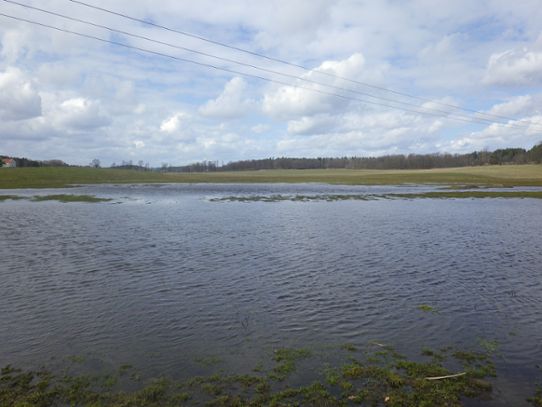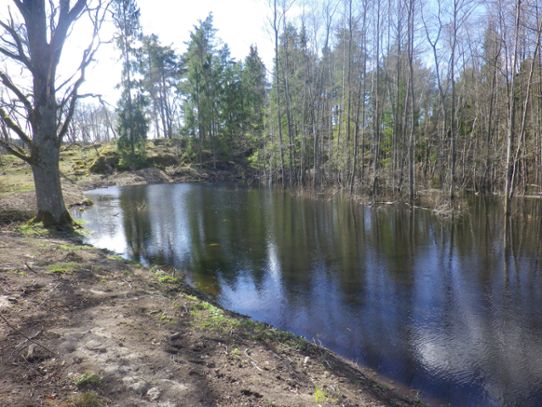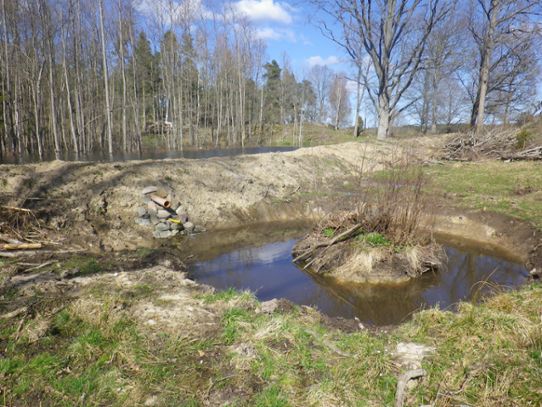Häckenstad Farm is outside of Gamleby in Västervik Municipality. The farmer, Fredrik Anderson, took over the farm in 2006 and has been farming organically since 2008. Fredrik produces KRAV-labelled meat and the cultivated land consists of arable land, pasture and woodland.
Frequent flooding
The quantity of precipitation in southern Sweden will probably increase up until the next century, which may increase the risk of flooding in the agricultural sector. The altered climate will therefore place greater demands on agricultural water facilities. Increased quantities of water means significantly higher drainage requirements, but this also has an impact on the ground’s ability to support agricultural machinery. A higher water level leads to poorer drainage on arable land and the roots of crops are at risk of suffering from a lack of oxygen.
Häckenstad Farm is located in a low-lying area and in 2010, the farm suffered a major flood when around 40 hectares of feed production was lost. The water remained in the ground for several weeks, leading to the crops dying. The need to deal with this problem grew and in 2011, when Fredrik was invited to participate in a project to reduce the leakage of nutrients using various means on the farm, he agreed as this would result in added value in the form of a lower risk of flooding.

Wetlands slow down the water and reduce the spread of disease
As the clay soil on Häckenstad Farm is very unstable, it is difficult to adjust the edges of ditches, meaning that the flow of water must be stopped higher up in the ground in order to reduce the risk of flooding. This was done by building three retardation ponds in the form of wetlands and two phosphorus ponds.

Wetlands are a measure that halt the flow of water through the landscape by collecting rainwater and thus also increase drainage and reduce the risk of flooding as a result. A phosphorus pond is a pond built in arable land in order to slow down water and phosphorus. The result is a reduced risk of nutrient leakage. Wetlands of various kinds contribute to controlling flow, recycling nutrients, collecting sediment, controlling erosion and preserving plant and animal life. The land area currently given over to wetland is 3 hectares.

The results are drier land in the area where the wetlands are located, with the positive effects covering a total of 50 hectares. Before the action was taken, 50 mm of rain resulted in major flooding problems; these amounts can now be handled without any negative impact on grazing or harvest.
Positive side-effects
One positive effect of drier pasture is the improved health of grazing animals as the spread of parasitic diseases has decreased as the land has become drier.
Effects of the solution
+ Fewer problems with flooded land
+ More steady flow in watercourses
+ The harvest has become more consistent and higher
+ More feed from the arable land
+ Reduced eutrophication in the Baltic Sea
+ Healthier animals
- Time consuming
- Laborious permit applications
- High construction cost
Financing and budget
Provisional costs (SEK)
Construction of ponds/wetlands 437 480
Permit application 1500
Own work 182 100
Total 621 080
Lessons learned and challenges
Since 2010, there have been no major floods on Häckenstad Farm. The measures have increased profitability and have improved the environment for the animals on the farm and as the work has progressed, new areas that could be improved have been discovered. In about 10 years, the entire farm will be protected from flooding. At this point, 5 hectares of the farm will be given over to environmental measures such as wetlands, phosphorus ponds and wider ditches.
The principal challenge has been the time devoted to administrative work with the construction of wetlands in the woodland. It is important that the positive effects are weighed up against all the time a wetland demands and a great deal of planning and interest is therefore required on the part of the individual farmer. The county administrative board issues permits for wetlands and can contribute a great deal of knowledge and information about what is involved in the process.
Häckenstad Farm is an example of an instance where many interests can be provided for and where the original aim has provided added value in the form of agriculture that is adapted to climate change. For his efforts, Fredrik Andersson was named Baltic Sea Farmer of the Year by the WWF in 2014.
More examples of climate adaptation
This is one of many examples of climate adaptation. There are more in the collection of ideas being built up by the Swedish National Knowledge Centre for Climate Change Adaptation at the Swedish Meteorological and Hydrological Institute (SMHI). The collection of examples has the aim of sharing experiences and providing ideas to everyone who works with climate adaptation. Examples describe concrete measures and challenges in several subject areas. They show how different actors have worked to adapt their activities to the climate changes that are already being noticed today and those that we cannot prevent in the future.